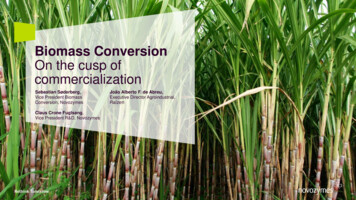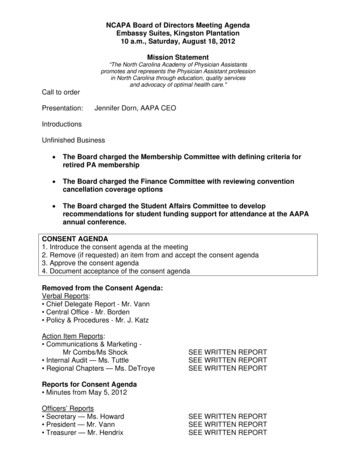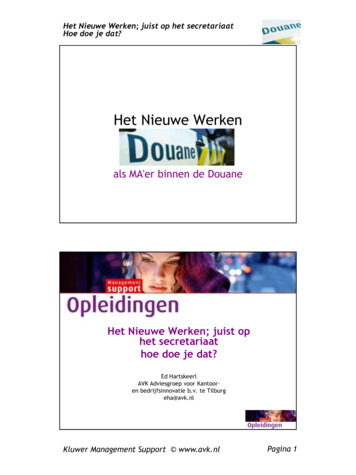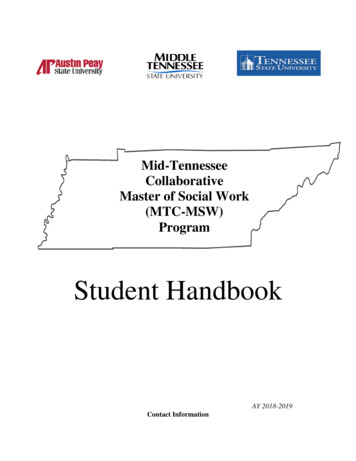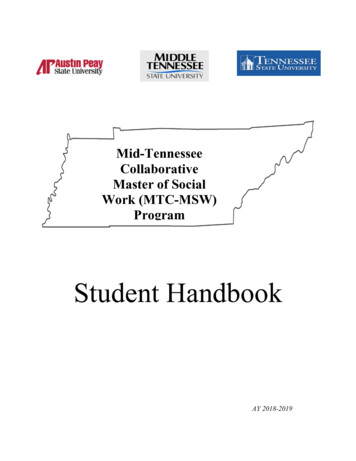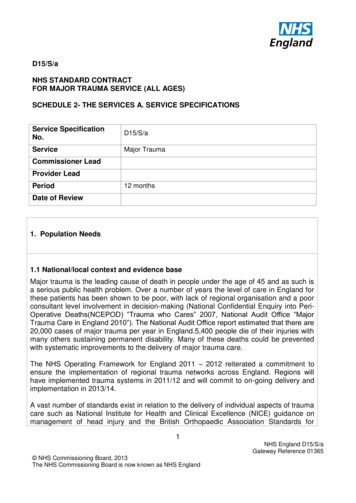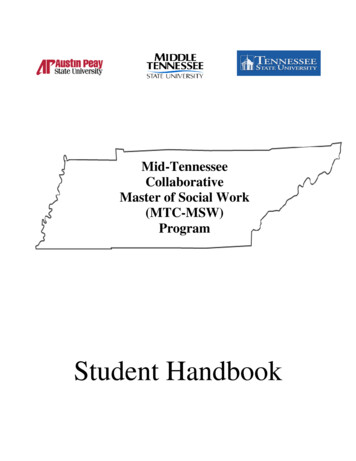
Transcription
Wednesday, December 13, 201711:00 am to 2:00 pmCASA Technical Committee Meeting #5Yerba Buena Conference RoomBay Area Metro Center, 375 Beale Street, San FranciscoAgenda11:00 amI.Welcome and Announcements 11:15II.Agenda Overview and Meeting Goals (Michael Covarrubias) Technical Committee Membership Update (Attachment 1) Update on Federal Tax ReformInteractive Workshop – Initial Brainstorming and Sharing onIdentifying Potential Elements of a “Grand Bargain”Co-Chairs, Steve Heminger, Jennifer Martinez, Linda Mandolini, DenisePinkston, Derecka Mehrens, Jennifer LeSarPart 1 – Setting the Stage Update on Protection Group Progress (Jennifer M./Linda) Update on Preservation Sub-Committee of Protection Work Group Review Preservation Actions Scoring (Attachment 2)Update on Production Work Group Progress (Denise/Derecka)Part 2 – “Grand Bargain” Potential Elements Identifying and Confirming Key Elements (Co-Chairs; Steve) Production, Protection, Preservation Key Elements Exercise Led by Work Group Co-Moderators (Denise/Derecka; JenniferM./Linda)What Else is Essential or Missing? (Jennifer LeSar)Part 3 – Where are we Headed? Potential Next Steps1:10 pmIV.Proposed Community Outreach Activities for 2018 (Attachment 3)Vikrant Sood1:25V.Public CommentKen Kirkey1:40VI.Update on MTC Housing Initiatives Overview (Ken Kirkey)MTC Housing Initiatives (Attachments 4 and 5) (Vikrant Sood)MTC’s Public Lands Study for Transit-Oriented Workforce Housing(Attachment 5) (Darin Smith)Darin Smith from the consulting firm of Economic and Planning Systems willshare key elements of an emerging action plan for the study, which willevaluate affordable and workforce housing development opportunities onpublicly-owned properties in the Bay Area.TC Agenda December 2017 FINAL
1:552:00VIISummary and Next StepsCloseAttachments:1. New Member(s) Bio(s)2. Scoring for Protection Actions3. Proposed Community Outreach and Engagement Plan4. Plan Bay Area 2040 Housing Actions5. Presentation for MTC Housing Initiatives and Public Lands StudyTC Agenda December 2017 FINAL
Aimee InglisAssociate Director Tenants TogetherAimee Inglis was trained as a community organizer through theMidwest Academy’s Organizing program, and has workedprofessionally on starting and managing volunteer programs anddeveloping education and outreach services for tenants’ rights. Shehas worked for housing justice for over six years, starting as avolunteer counselor on Tenants Together’s ‘Tenant Rights Hotline.’As staff, her role at Tenants Together has evolved from developingits volunteer and tenant education programs to online organizingand communications to currently leading organizationaldevelopment as Associate Director.474 Valencia St. #156, SanFrancisco, CA 94103P: (415) 495-8100 x1001E: Aimee@tenantstogether.orgAs California’s only statewide renters' rights organization, TenantsTogether works to improve the lives of California’s tenants througheducation, organizing and advocacy. Tenants Together seeks togalvanize a statewide movement for renters’ rights. Supported bymembers and member organizations, Tenants Together works toempower renters to assert their rights and provide the tools toorganize and advocate in their own communities. Working together,we build the power and political will to win economic justice.Agenda Item 1 Attachment 1
Michele ByrdDirector, Housing and Community Development Department City of OaklandMichele Byrd has been serving as the Director of the city ofOakland’s Housing and Community Development Department sinceFebruary 2012. She has demonstrated her leadership across a widebreadth of programs and partnerships ranging from theestablishment of the Housing Assistance Center to provide servicesin response to the Foreclosure and Housing Crisis, to the passageof amendments to the Rent Adjustment Ordinance and her proactiverole in advocating for the passage of a 25% set aside in response tothe difficult loss of Redevelopment funds for Affordable Housing.Prior to her current role, she served as Deputy Director of Housingand Community Development. Ms. Byrd began her career with theCity of Oakland as the Manager of the Community DevelopmentBlock Grant Program. She previously held the position of SpecialProjects Manager for the City and County of San Francisco. Ms.Byrd holds a Master’s Degree in Public Administration fromCalifornia State University, Hayward and a Bachelor’s Degree inPolitical Science from University of California, Davis. She serves onthe Board of Directors of the East Bay Rescue Mission and the BayArea HomeBuyer Agency.Incorporated in 1852, Oakland is the eighth largest city in California,with a population of 420,000 and a wealth of resources andopportunities.250 Frank H. Ogawa PlazaSuite 5313, Oakland, CA94612P: (510) 238-3714E: ophelia.basgal@gmail.mLocated on the east side of the San Francisco Bay, Oakland isbordered by 19 miles of coastline to the west and rolling hills to theeast, which provide unparalleled vistas of the Bay and the PacificOcean.Agenda Item 1 Attachment 1
Topic: PreservationDate: October 2017Total response from CommitteeMembers (16 responses)“BIG HIGH-IMPACT ACTION IDEAS”INPUT TEMPLATEAction IdeasIdeas should be big, high-impact ideas that canmove the needle on the Bay Area housing crisis, andare within CASA’s ability to influence or directly actupon.(Details may go in attachments, or via links)Action supportswhichKey Goal?List more thanone if applicableProtectionProductionPreservationTime Frame forImplementationShort-Term0-2 yearsMed-Term2-5 yearsLong-Term5-10 yearsWhat will it take to get this l FundingStatewide FundingRegulatory ReformEducation and AdvocacyPilots & spreading Best-PracticesOtherI. PRESERVATION OF EXISTING AFFORDABILITY OF DEED RESTRICTED AND UNRESTRICTED HOMESAdopt a regional “no-net loss” policyPreservation Short to Medium1, 4 Legislation or regulation thatfor homes affordable to lower-incomeTermestablishes a policy/law, and ishouseholds (requiring replacement ofcoupled with adoption of regionalany units removed due to newactions and incentives (includingdevelopment)infrastructure investment decisions).Condition regional transportationfunding on rigorous enforcement ofhousing preservation law intended topreserve deed-restricted affordablehousingPreservationShort Term2, 4 Adoption of policies/laws thatstrengthen preservation of theexisting affordable housing stockEnsure that preservation of theaffordable housing stock (acquisition,rehabilitation, and conversion) isincluded in funding measures.PreservationShort to MediumTerm7 As funds are created, or asprograms are designed or expanded,local jurisdictions should includehousing preservation as an eligibleproject typeInvestigate the use of Corporate andMunicipal Treasury funds undermanagement for acquisition,rehabilitation, or conversionPreservationMedium Term2 Identify a funding source tocomplete this work (if necessary)“NR” No Response“%1,2,3” % of respondents rating 1,2 or 3MeasurableOutcomesRating ScaleAdd achievable outcomes ifknown.1 Strongly Agree2 Agree but with reservations3 Neutral or Abstain4 Disagree, but will go along5 Strongly DisagreeReasonable guesses OK!(circle one)1 2 3 4 5 NR5 6 4 0 0 194% 1,2,31 2 3 4 5 NR9 4 3 0 0 0100% 1,2,31 2 3 4 5 NR14 1 0 1 0 094% 1,2,31 2 3 4 5 NR9 4 1 0 1 188% 1,2,3Agenda Item 2 Attachment 2
Action IdeasIdeas should be big, high-impact ideas that canmove the needle on the Bay Area housing crisis, andare within CASA’s ability to influence or directly actupon.(Details may go in attachments, or via links)Action supportswhichKey Goal?List more thanone if applicableProtectionProductionPreservationTime Frame forImplementationShort-Term0-2 yearsMed-Term2-5 yearsLong-Term5-10 yearsWhat will it take to get this l FundingStatewide FundingRegulatory ReformEducation and AdvocacyPilots & spreading Best-PracticesOtherMeasurableOutcomesRating ScaleAdd achievable outcomes ifknown.1 Strongly Agree2 Agree but with reservations3 Neutral or Abstain4 Disagree, but will go along5 Strongly DisagreeReasonable guesses OK!(circle one)6 Work with local corporations andkey cities to gain support for thisfunding sourcePromote and enforce condominiumconversion ordinances that givetenants the first right of refusal topurchase their homes before they areoffered on the marketPreservationShort to MediumTerm2 Identify a funding source topromote new ordinances andmonitor compliance1 2 3 4 5 NR4 8 2 0 0 194% 1,2,36 Work with local governmentagencies to adopt condominiumconversion ordinances7 Monitor compliance with existingordinancesProvide technical assistance andfunding for seismic retrofits andconstruction techniques that preservethe long-term affordability of theregion’s housing stockPreservationII. FUNDING ALLOCATIONS TO INCENTIVIZE HOUSINGAdopt Ellis Act reform to prevent SROs Preservationfrom being converted to market-ratehotelsShort to MediumTerm2 Identify a funding source to providetechnical assistance1 2 3 4 5 NR9 2 4 0 0 0100% 1,2,36 Create tools, policies, andprograms that local governments canuseMedium Term1.Sponsor legislation to amend theEllis ActPreservation and Protection Ideas Draft -- Page 21 2 3 4 5 NR7 3 4 0 0 194% 1,2,3Agenda Item 2 Attachment 2
TO:CASA Technical CommitteeFR:Ken Kirkey, MTCRE:DRAFT Community Outreach and Engagement PlanDATE:Dec. 6, 2017Several communications-related activities are currently in place to facilitate public engagement forthe CASA process. These include a CASA project webpage, news and information on MTC andABAG website, stories and e-newsletters, and a mailing list to disseminate information to the public.A broader outreach to disadvantaged communities is planned for 2018 to seek ideas and input on the“grand bargain.” This memo describes these outreach activities for review and approval by theTechnical Committee.Two key considerations should guide the outreach and engagement plan: Any public engagement for CASA must build on previous outreach by MTC and ABAG. Thetwo agencies engaged communities across the region on housing-related challenges throughoutthe Plan Bay Area 2040 process. MTC/ABAG also hosted a regional housing forum in early2016 with 300 attendees from various sectors. Many of these discussions focused on identifyingissues related to housing affordability in the Bay Area. The next time MTC engages thesecommunities, the dialogue should therefore focus on responses to community concerns.Technical Committee members are themselves a wealth of information. They were selectedbecause of their expertise, including knowledge of issues facing their constituents. The CASAprocess anticipates that Technical Committee members will engage with their constituentsdirectly person-to-person and organization-to-organization to seek, review, and confirm supportfor emerging ideas.With these considerations in mind, below are details of proposed outreach activities for 2018,including events hosted by the mayors of the region’s three big cities; a potential telephone poll; anda series of meetings hosted by select community groups, with stipends provided by MTC.1. In spring 2018, when staff anticipate working groups and committees would have developed anoutline of the package of high-impact strategies, MTC will support the mayors of the three bigcities to host a public event for working group and committee members to present and get earlyfeedback on ideas and recommendations. A similar event will be held in the North Bay.2. In order to engage communities traditionally underrepresented in government decision making,MTC will provide resources to community-based organizations to directly reach out to lowincome residents in the region who are impacted by the housing affordability crisis. MTC willprovide a 5,000 stipend each to four community-based organizations (CBOs) to host andconduct the first of two rounds of outreach meetings with disadvantaged communities, to servethe same purpose as #1 above. These meetings will also occur in spring 2018.3. In fall 2018, when staff anticipate working groups would have developed their close-to-finalrecommendations for a comprehensive package of actions and strategies to address criticalhousing issues, MTC will (if resources are available) conduct a statistically valid telephone poll1 of 2Agenda Item 4 Attachment 3
of Bay Area residents to gauge political feasibility of these recommendations. This informationwill also be critical for advocacy in Sacramento.4. Also in fall 2018, MTC will provide a second round of stipends to the same community-basedorganizations to conduct a second round of meetings with disadvantaged communities. Thesediscussions will focus on the close-to-final recommendations.5. In late 2018, MTC will develop and disseminate collateral material to share with a broad range ofstakeholders, including residents in the Bay Area, policymakers, legislators, business, communitygroups, etc.6. Also in late 2018, MTC will host a “celebration” to coincide with the final Steering Committeemeeting to share results from the CASA process.Ongoing OutreachThroughout the process, MTC will continue to maintain the CASA website, social media accountsand mailing list to disseminate information to the public. MTC may add additional components tobolster the media strategy such as press events at key milestones.2 of 2Agenda Item 4 Attachment 3
Action PlanObjectivesTransit-oriented development.Credit: Martin KlimekSimilar to past regional achievements in theenvironment, transportation and economy,successfully addressing these needs during theimplementation of Plan Bay Area 2040 will require ashared commitment among regional policymakers,local governments and civic organizations, as well asrobust public engagement and participation. MTC andABAG will provide semiannual reports on Action Planprogress and implementation to joint meetings of theMTC Planning Committee and ABAG AdministrativeCommittee during the early part of the regionalplanning process for the next Plan Bay Area.Housing Production,Preservation andProtectionAs described earlier in “The Bay Area Today,”the region faces many housing challenges, fromskyrocketing costs to overcrowded housing tolong commutes. Regional agencies, however,currently lack the tools, resources or authority toPLAN BAY AREA 2040 ACTION PLAN The recommendations in this ActionPlan address multiple performancetarget areas. housing: Lower the share ofincome spent on housing andtransportation costs, lessendisplacement risk, and increase theavailability of housing affordableto low- and moderate-incomehouseholds. economic development:Improve transportation access tojobs, increase middle-wage jobcreation, and maintain the region’sinfrastructure. resilience: Enhance climateprotection and adaptationefforts, strengthen open spaceprotections, create healthy andsafe communities, and protectcommunities against naturalhazards.Agenda Item 6 Attachment 475
What ActionsHave the RegionalAgencies AlreadyImplemented forHousing?To date, regional agencies have largelyfocused housing actions on fundingplanning grants, conducting the RegionalHousing Needs Allocation (RHNA),conditioning transportation funds on localplanning and the production of housing,using existing fund sources for incentivesand direct investments in affordablehousing, providing best practices andtechnical assistance, advocating thestate legislature for statewide legislativeproposals to reduce barriers to housingproduction, and hosting forums to furtherinformation sharing and policy solutions. Conditioned approximately 600 million in One Bay Area Grant(OBAG) funds on the adoption ofan approved housing element andconditioned nearly 20 billion intransit expansion priorities onminimum zoning via TOD policy. Awarded 51 PDA Planning grantsto date, which have led to increasedplanning capacity for 70,000 housingunits, 110,000 jobs and 26 millionsq. ft. of commercial development.PDA Plans remove barriers to infilldevelopment by creating a predictablepermitting process aligned withcommunity objectives. Adopted a new OBAG framework in2016 to increase incentives and directinvestments for affordable housing. housing, including the Housing Forum,Housing Subcommittee of the RegionalPlanning Committee, and CASA — TheCommittee to House the Bay Area.More specifically, MTC and ABAG have: Produced Regional Housing NeedsAllocations (RHNA) and monitoredRHNA performance by income-level. Invested in the Transit OrientedConvened regional committees for Supported CEQA modernization andcreated an online guide to CEQAstreamlining provisions.Affordable Housing (TOAH) revolvingloan fund.PLAN BAY AREA 2040 ACTION PLAN76Agenda Item 6 Attachment 4
Housing in Santa Clara County.Credit: Karl Nielsendirectly address identified issues of production,affordability and displacement. In response, theAction Plan recommends pursuing more ambitiousfunding, legislative and policy solutions at the state,regional and local levels as well as strengtheningand expanding existing regional housing initiatives.Regional agencies will partner with state and localgovernment, business leaders, and nongovernmentalorganizations (NGOs) to identify and implementgame-changing housing solutions that will facilitateimproved housing performance by: producing morehousing, particularly housing affordable to very low-,low- and moderate-income households; preservingexisting housing that is affordable to very low-, lowand moderate-income households; and lesseningdisplacement risks faced by existing residents. Manyof the solutions will require changes in state law anddevelopment of new funding formulas that do notcurrently exist.Two new endeavors will improve the region’s ability toaddress its chronic housing affordability challenges.The recent integration of MTC and ABAG staff will leadto more effective long-range planning and increase theregion’s housing policy capacities. The newly createdCASA initiative is bringing together diverse intereststo develop a bold new strategy for housing productionand preservation. Together these efforts willexpand data gathering and technical assistance andrecommend a range of legislative, funding and policymeasures to help provide for the region’s housingneeds at all income levels.CASA—The Committee to House the Bay AreaMTC and ABAG are helping to coordinate CASA — The Committee to House the BayArea. This initiative is bringing together a multi-sector set of partners to identify andagree upon significant regional solutions that address the region’s chronic housingchallenges and advance equity and economic health in the nine-county Bay Area.Through stakeholder engagement, research and interviews, CASA will develop acomprehensive regional approach to the housing crisis, focusing on increasing housingsupply, improving housing affordability, and strengthening preservation and antidisplacement measures. Objectives include a suite of legislative, financial, policy andregulatory recommendations, with partners agreeing on a path forward and workingtogether on implementation. A final report is scheduled for release by the end of 2018.PLAN BAY AREA 2040 ACTION PLAN Agenda Item 6 Attachment 477
This Action Plan makes the following recommendations for Housing:Partners andTimeframeHousing ActionsAdvance regional “self-help” funding and financing solutions for housing: Develop a plan for generating regionalrevenues for the production and preservation of housing affordable to low- and moderate-income households (could includemeasures such as a parcel tax, commercial linkage fee or other dedicated funding). Evaluate the creation of innovative financingtools, such as a regional infill Infrastructure Bank, a land bank or a Regional Housing Trust Fund, to support new housing orinfrastructure improvements.Advance state legislative and funding solutions: Support state legislative or funding opportunities that advance the objectivesof this Action Plan, including securing a permanent source of affordable housing funding, increasing community stabilization andlessening displacement risk, reducing costs and barriers to housing development, incentivizing developers to create workforceand low-income housing, incentivizing the creation of accessory dwelling units, as well as other measures that will contribute toincreased supply of both market-rate and affordable housing.Build on recent housing policy successes: Implement the housing and community stabilization initiatives adopted in the secondcycle of the One Bay Area Grant (OBAG) program from 2017-18 to 2021-22, such as the Preservation Pilot (previously known asNOAH), 80k by 2020 initiative, Transit-Oriented Affordable Housing (TOAH) fund, and JumpStart program to encourage equitableand sustainable development. Evaluate the performance of these strategies and applicability of expanding these types of loan anddirect investment programs for future funding programs.Evaluate expanded policies connecting transportation funding to housing production and performance: Analyze thefeasibility of incentivizing housing production with pertinent existing and new transportation funding sources, with particularemphasis on housing affordable to very low-, low- and moderate-income households as well as anti-displacement and communitystabilization. Develop a strategy for the use of public land proximate to major transit assets to facilitate the development ofhousing affordable to low- and moderate-income households through conditions and provisions on funding sources. Report to theCommission on all discretionary funding sources where such housing provisions and conditions may be added.Provide technical assistance and best practices to local jurisdictions related to the transformation of “opportunityareas”: Assist local agencies as they envision upgrades to low-intensity office parks and retail centers to create mixed-use, mixedincome neighborhoods with significant housing.Strengthen technical assistance and policy leadership for housing and community stabilization: Expand and transformregional agency technical assistance for local jurisdictions that is tailored to both Bay Area-wide challenges and challengesunique to specific parts of the region, including best practices to support new housing (e.g., heights that support more units andallow projects to “pencil out” without compromising neighborhood character). Focus areas for technical assistance could includeguidance on implementing state legislation for transit-oriented development and the production of housing affordable to low- andmoderate-income households, guidance on housing preservation and locally appropriate community stabilization and antidisplacement policies, supporting healthy infill development, and coordination of neighboring jurisdictions along transit corridorsand in subregions to identify shared solutions to housing challenges. Explore new and expanded community stabilization and antidisplacement policies to support low-income renters, including incentives for landlords to keep existing rents affordable.Close data gaps and improve information accessibility: Continue to collect, analyze and disseminate data about housingopportunity sites and vacant lands, zoning, development trends and policy implementation by local governments to informlocal, regional, and state policy development and evaluation, including PDA performance. Create accessible database of majordevelopment and publicly owned sites. Create an online Policy Directory with examples of ordinances being implemented atthe local level to address community stabilization. Continue to evolve RTP/SCS Project Performance methods to seek strongeralignment between prioritizing transportation projects and housing performance.MTC/ABAG, CASA,local jurisdictionsEvaluateExecuteState legislature,MTC/ABAG, CASA,local jurisdictionsMTC/ABAG, CMAs, CASAMTC/ABAG, CASA,the Partnership, regional leaders,local jurisdictions, transit operatorsEvaluateExecuteMTC/ABAG,local jurisdictions, CASAOngoingMTC/ABAG, local jurisdictions,BAAQMD, CMAs, CASAOngoingMTC/ABAGOngoingTABLE 5.1 Plan Bay Area 2040 “Action Plan” recommendations for housing.Source: Metropolitan Transportation Commission, Association of Bay Area Governments, 2017PLAN BAY AREA 2040 ACTiON PLAN78Agenda Item 6 Attachment 4
Plan BayArea 2040HousingInitiativesCASA Technical CommitteeDecember 13, 2017Agenda Item 6 Attachment 50
Key Initiatives Underway Housing Funding and Financing Programs Transit-Oriented Affordable Housing (TOAH) Revolving Loan ProgramBay Area Preservation PilotRegional Infrastructure BankJumpstart ProgramConditioning of Transportation Funding Tracking Compliance with State Law (housing elements,ADUs, public lands, etc.) One Bay Area Grant (OBAG) Program (may be expanded)80K by 2020 ChallengeTechnical Assistance and Planning Programs Priority- Development Area (PDA) Planning and Technical AssistanceProgram Local Jurisdiction Technical Assistance ProgramPublic Lands StudyHousing Policy ToolkitData Collection and Monitoring Housing PermitsAgenda Item 6 Attachment 51
Upcoming Initiatives / Assessments Housing Funding and Financing Programs Conditioning of Transportation Funding Jobs-Housing Linkage FeeTechnical Assistance and Planning Programs Regional Housing Trust FundOpportunity AreasData Collection and Monitoring Housing Permit Database / Dissemination ToolAgenda Item 6 Attachment 52
Public Lands Study:Transit-OrientedWorkforce HousingAssessmentOverview/ActionsDarin Smith, EPSAgenda Item 6 Attachment 53
Project Overview Identified potential sites for workforce/affordablehousing:– Within ½ mile of transit facilities– Owned by public agency (city, county, state, fed, etc.)– With reasonable size and proportions– With limited existing public use so potentially developable– Near amenities and services that can attract funding Assessed range of development types/pro formas Recommends next step actions for local agenciesand MTC to advance affordable/workforce housingdevelopmentEconomic & Planning Systems, Inc.Agenda Item 6 Attachment 54
Site ExampleEconomic & Planning Systems, Inc.Agenda Item 6 Attachment 55
Inventory Results by Owner – Top 10 AgenciesOwnerSitesAcresBARTState of CAVTASamTransUnion City Community RedevelopmentSanta Clara CountyCity and County of San Francisco*City of OaklandSouth San Francisco RedevelopmentCity of San Jose3417421167219115574229181514131098* San Francisco was not initially included in study scope because San Francisco public lands study was underway. San Francisco owns some landoutside its own borders as reflected above. Results to be updated following completion of SF study/MTC additional analysis.Economic & Planning Systems, Inc.Agenda Item 6 Attachment 56
Other Site Analysis Findings1. Workforce and Affordable Housing requires subsidy– Development costs exceed price-restricted value regardlessof project type or location– Affordable housing development costs typically equal orexceed market-rate project costs2. Public land can be a valuable source of subsidy– Reduced cost vs. market-rate land transaction– Leverage as local match for other funding sourcesNote: San Francisco work to be completed– San Francisco not initially included in analysis because the city hadinitiated its own public lands study. MTC to review those findings,update as needed and fold results into study.Economic & Planning Systems, Inc.Agenda Item 6 Attachment 57
Action Plan – Overview Provides context for housing developmentand funding issues Recommends agency/MTC actionsEconomic & Planning Systems, Inc.Agenda Item 6 Attachment 58
Recommended MTC Actions Continue to Link Funding and HousingProduction Fund Project Infrastructure– Replacement parking Support Technical Assistance for PropertyDisposition Create Flexible Funding Sources– Regional infrastructure fund, Regional land bank Lobby for Legislative ChangeEconomic & Planning Systems, Inc.Agenda Item 6 Attachment 59
Political Science from University of California, Davis. She serves on the Board of Directors of the East Bay Rescue Mission and the Bay Area HomeBuyer Agency. 250 Frank H. Ogawa Plaza Suite 5313, Oakland, CA 94612 P: (510) 238-3714 E: ophelia.basgal@gmail.m Incorporated in 1852, Oakland is the eighth largest city in California,
